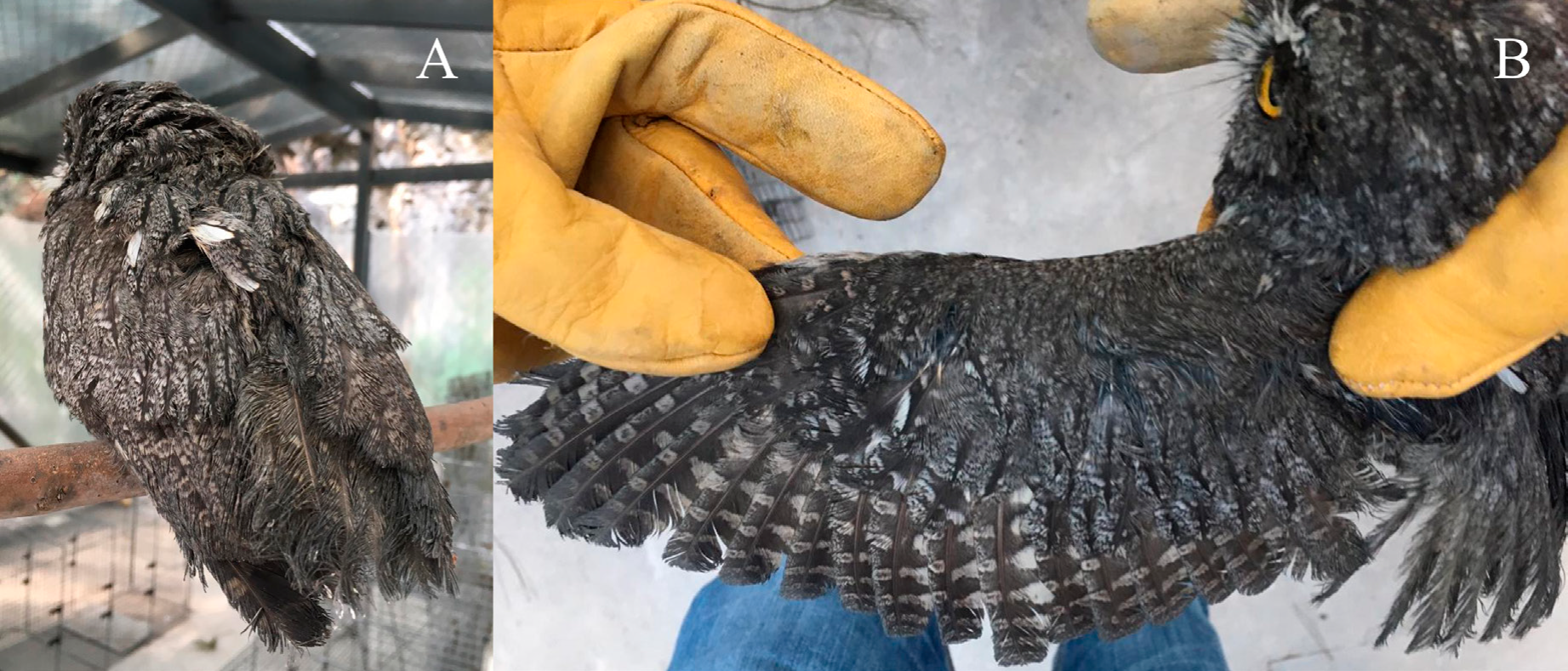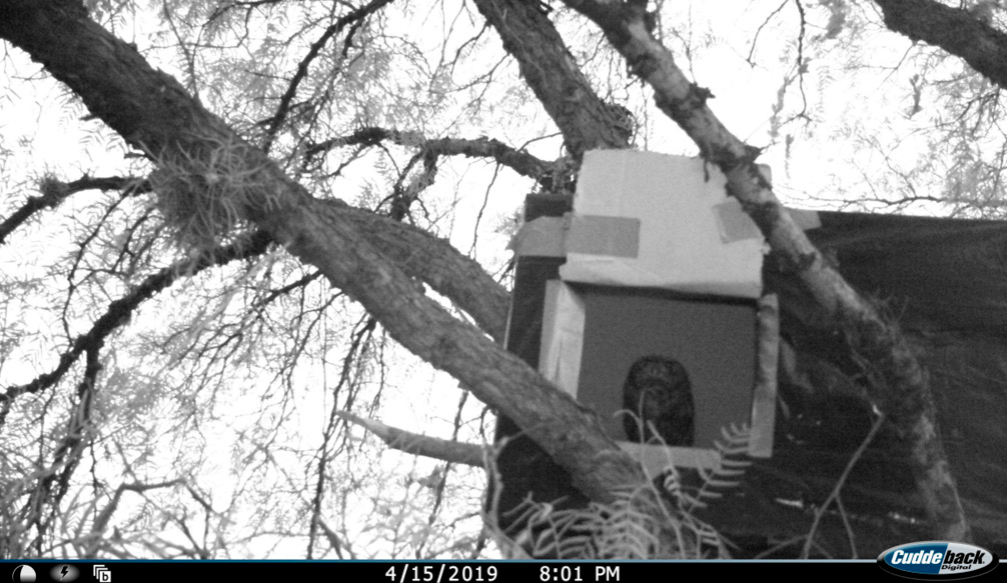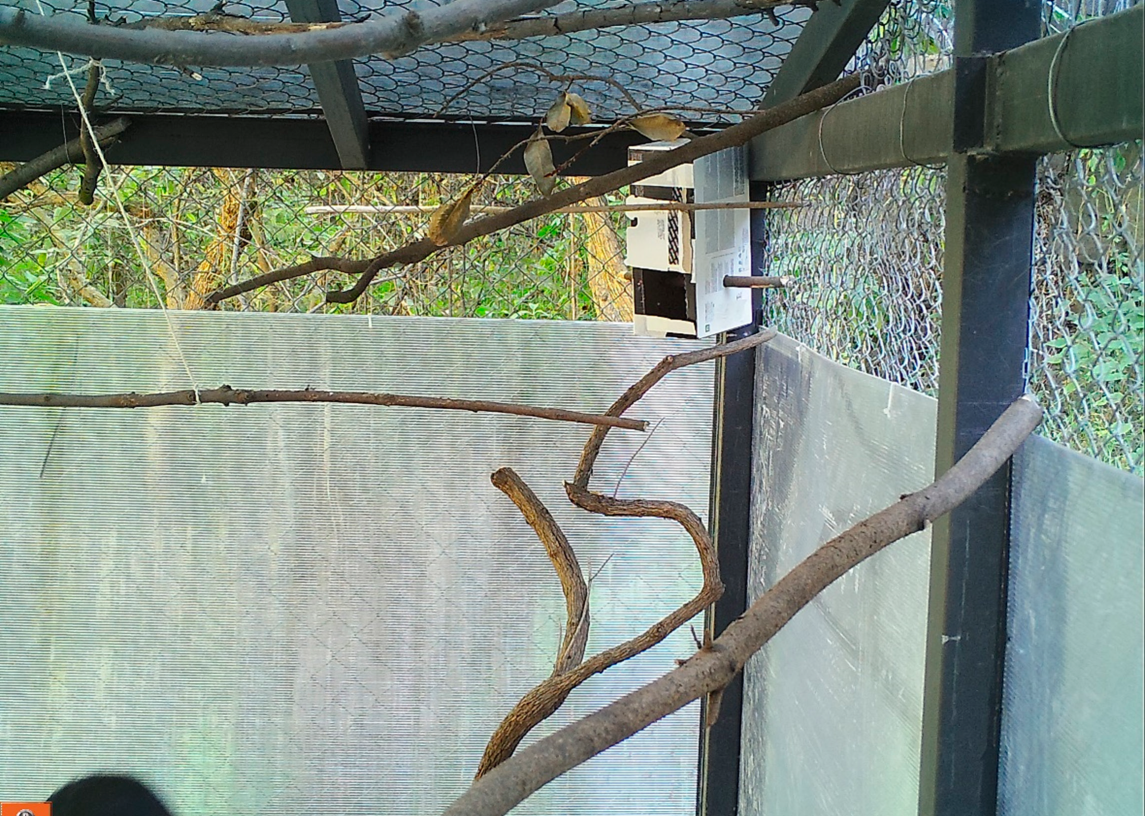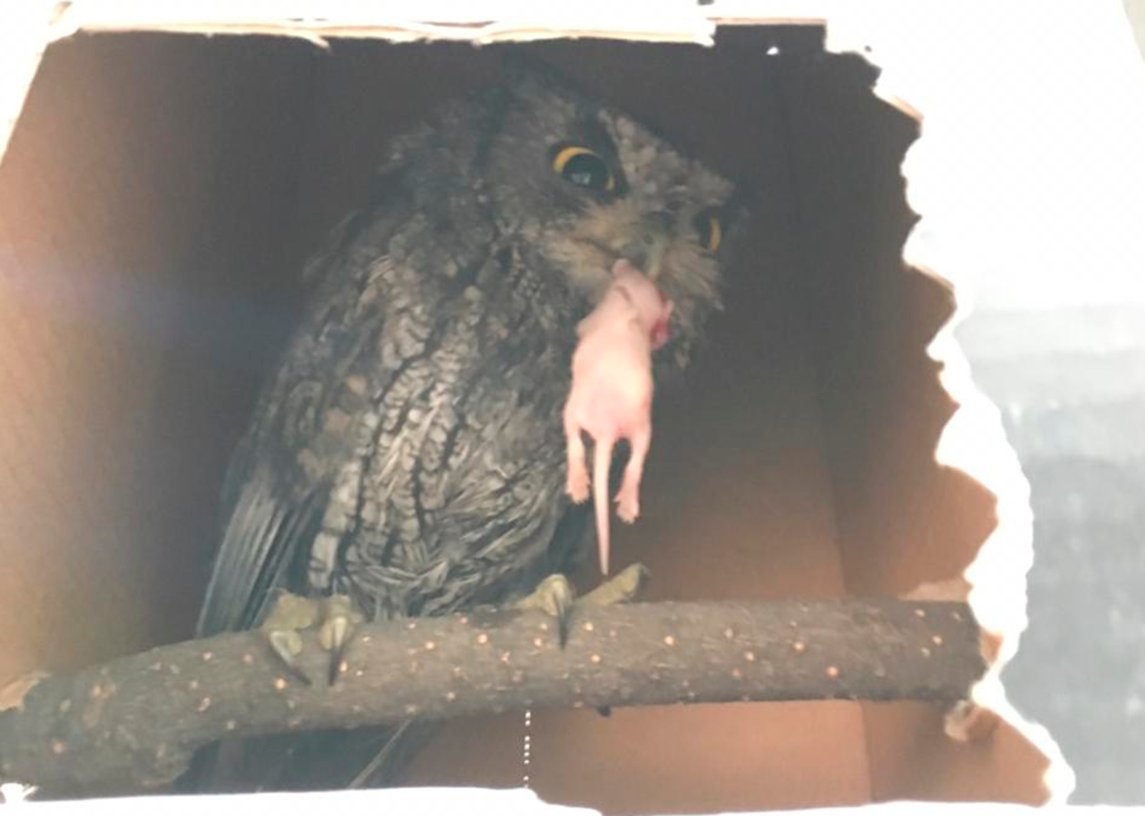Introduction
The Wildlife Care Center from El Pedregal de San Angel Ecological Reserve [CAF-REPSA, after its Spanish acronym] is loca ted in southern Mexico City, inside the Universidad Nacional Autónoma de México [unam]. The reserve is covered with petrified lava and xerophytic scrubland and consists of 237.3 fragmented hectares without natural corridors (Castillo et al. 2007). Around 300 wild animals are handled for medical care yearly (opossums, rattlesnakes, ringtails), also local authorities report external injured wildlife of Mexico City to the CAF-REPSA such as opossums, toucans, elf owls among others.
The latest admission was a whiskered screech-owl (Megascops trichopsis). This is the second smallest Mega-scops species (length 17 - 19 cm, weight 70 - 121 g) in Mexico (Estay-Stange et al. 2019). The geographical distribution of M. trichopsis ranges from southeastern Arizona to northern Nicaragua (Howell and Webb 1995). This is a dimorphic species characterized by the elongation of feathers of the facial discs that resemble whiskers. They have feathered tarsus, the color of the irides is yellow and the cere and bill are grey or greenish yellow (Marks et al. 1999). Its habitat includes oak, pine-oak forests, and shade coffee plantations across altitudes from 700 to 2800 masl (Ortiz-Pulido and Lara 2014), where they nest in natural cavities or in old nests of other birds like woodpeckers (Colaptes spp, Estay-Stange et al. 2019). The foraging strategy of this species is to wait perched in a tree and make short flights to capture prey in flight or directly from the ground (Marks et al. 1999). Its diet consists mostly of arthropods including grasshoppers, beetles, moths, centipedes, caterpillar and even vertebrates, such as lizards and rodents; these last mainly during the breeding season (Duncan et al. 2003). Little quantitative information has been published about this species. In the present report we document the rehabilitation process of a M. trichopsis and their hematology and biochemistry values with the aim of generating information that helps in further cases of owl rehabilitations.
Methods
The people that brought the owl to the CAF-REPSA reported that they found the wild bird near a tree in a vulnerable condition without parents. They kept the owl for four months in a 2 × 2 × 4 m cage and fed it with chicken breast. It was brought to the wildlife care center for a proper handling and evaluation for possible rehabilitation and releasing into the wild.
Animal evaluation
Initial clinical diagnosis included a careful observation of posture and awareness of the bird, musculoskeletal or neurologic abnormalities, weight determination, temperature, and age class. In addition, an examination of oral cavity, ears, and nares, heart and respiratory rate were evaluated to estimate the recovery potential (Graham and Heatley 2007).
Captivity conditions
The owl was housed in 4.5 × 4.5 × 5 m cage with sides and top covered by wire netting. The cage was equipped with wooden perches from trees of the area (Figure 1), water ad libitum in a 10 cm depth container and an artificial nest made out of carton box 30 × 20 × 60 cm placed at 1.8 m above the ground to improve physical condition and vertical flights. Limited human contact was essential to prevent the owl habituation, to improve its success as predator in the wild, and to reduce stress (Patton et al. 1985). Most of the cage floor (90%) was covered with dirt and leaf litter with a 4cm depth to stimulate owl foraging (hunt) on insects and dust baths.
Diet
Using live prey (insects and rodents), we replicated the hunting behavior of the owl in the wild to improve the physical condition and flight abilities (Duncan et al. 2003, Greene et al. 2004). Raptors naturally eat a diet low in carbohydrates (2%) and high in fat (2% - 28%) and protein (17% - 20%). To determine the owl’s feed amounts requirements we used the basal metabolic rate (BMR) of = 78 (for non-passerines) (kg) ^ 0.75 and for physical reconditioning we used a maintenance energy requirement (MER) of = 2.5 × bmr to improve Kcal/day. For reference, a typical mouse contains 55 - 65 kcal of energy (Scott 2016).
Flight fitness
To improve survival of the owl after release, muscle fitness should be satisfactorily restored to allow the raptor hunt succe ssfully (Greene et al. 2004). To recondition the owl, we used two flight techniques; the first consisted in supplying live preys inside the cage to encourage the owl for hunting from the perches at the top of the cage to the ground (Lawrence 1997). The second was performed with short flights indoors un-restrained from one perch to another for several times (Greene et al. 2004). Also, a restrained flight outdoors into a large open field by attaching a long line (creance) to the leather anklets (jesses) on the owl’s tarsi (Llewellyn and Brain 1984, Redig et al. 2007). Once the owl was prepared with this equipment, it was transported to an open area with grass to assure soft landings and without trees to prevent the creance getting tangled. In this open area, we encouraged the owl to fly until landing. We evaluated the success of the physical reconditioning indirectly. It has been reported that once the bird can make 8-10 flights of about 60 meters each without resting, it can be considered a successful reconditioning (Redig et al. 2007). On average, this goal can be achieved by practicing the creance flights 3 - 4 times for week for 4 - 6 weeks (Redig et al. 2007).
Additional assessments
To detect the presence of endoparasites, we collected fresh feces samples inducing the owl to defecate on handling and during flights. Serial samples were collected, placed in sterile tubes and analyzed by Flotation and Faust methods. Also, a complete ophthalmologic examination (sensuWilliams 2012) was performed to evaluate if the owl presented any ophthalmic alteration that put on risk their survival or their hunting capabilities.
Blood sampling
The blood analysis was carried out after diet, flight and enclosure conditioning to avoid affecting the values (i.e., one month after admission). The owl was physically restrained prior to sampling. The sampling area was cleaned with an antiseptic. Blood was taken by venipuncture of the brachial vein using 27-gauge needles and 1 ml plastic syringes. It was bled before being fed, and 0.7 mm of blood was collected and divided in two tubes: 0.35 ml in Microtainer® bd coated with edta for a cbc and 0.35 ml blood were emptied in Microtainer® bd without anticoagulant for blood biochemistry. Each sample rested for 15 min before being placed in a cooler (Termo Medic®) at 4 ºC. Sample was processed in less than 3 h after collection using the impedance technique and Colometric technique. Hematologic values assessed included red blood cell count (RBC), hemoglobin concentration, packed cell volume (PCV), mean corpuscular volume (MCV), total protein (TP) and total white blood cell count (WBC) which was performed according to standard methods (Harvey 2001, Rebar et al. 2001, Lara 2013). The differential count of leuko-cytes was performed manually using blood smears stained with Wright-Giemsa dye. Based on the count of 100 cells per smear Lymphocytes, Heterophils, Eosinophils, Monocytes and Basophils were estimated (Harvey 2001, Rebar et al. 2001, Lara 2013). A concentration of 23 parameters were evaluated for blood biochemistry, including Glucose, Urea, Uric Acid, Creatinine, Cholesterol, Calcium and Phosphorus, among others.
The owl release was decided by results of physical examinations, screening for internal parasites, hematology values, body weight, flight fitness assessment, and successful live prey capture (Black et al. 2011).
Results and Discussion
At the time of the admission, the owl weighted 103 g. After the physical evaluation, the owl was reported as clinically healthy with no evidence of pathologies, but unable to fly and to hunt (Table 1). The owl spent two months at the CAF-REPSA. The owl primary feathers were dirty and greasy, and the tail feathers were covered with feces (Figure 2). We cleaned the owl feathers one by one using soapy warm water (sensuWelte and Frink 1991). The diet provided consisted mainly of rodents (Rattus norvegicus and Mus musculus), darkling beetle larvae (Zophobas morio) and speckled cockroaches (Nauphoeta cine-rea). Initially the feeding was performed daily in the afternoon, offering dead day-old neonatal (pinky) mice without hair to avoid gastrointestinal alterations (Figure 3). Two days later, live dizzy mice were added to stimulate the hunting behavior as well as the dead pinky mice. Owl pellets were observed eight days after the diet changed suggesting an adequate digestive process. Attempts were made to induce the owl foraging on insects that were placed in the leaf litter two days per week, without rodents. Insect exoskeletons were found in the owl pellets confirming their intake. Adult rodents were introduced to enhance the hunting process and 12 days after rehabilitation began the owl hunted successfully an adult rodent. The owl kept this hunting behavior until the end of the rehabilitation process.
Table 1 Comparison between physical conditions and flight and hunting capabilities of the whiskered screech-owl (Mega-scops trichopsis) at the time of admission and after the rehabilitation process.
| Conditions and capabilities | Initial evaluation | Final evaluation |
|---|---|---|
| Weight (g) | 103 | 120 |
| Muscle condition | Keel bone apex evident | Pectoral muscles cover the keel apex |
| Feathers condition | Flight feathers dirty and greasy, tail feathers covered with feces | Plumage in optimal conditions |
| Ophthalmological exam | No alterations detected | No alterations detected |
| Flight capability | Unable to fly | Capable to make vertical and long flights (> 30 meters) |
| Hunt capability | Unable to hunt live prey | Capable to hunt live prey |
| Signs of habituation to human contact | Without signs of habituation | Without signs of habituation |

Figure 2 Owl plumage condition. (A) Flight feathers dirty and greasy. (B) Left wing examination; tail feathers co vered with feces.
Indoor flights were performed 10 to 20 times late in the afternoon, five times per week and 15 days after the diet changed. Flights were performed during a four week period. Wooden perches were moved 4 m between them to ensure at least 40 m of flight distance. Outdoor flights were performed three times per week, 5 to 10 repetitions with a 15 m creance. The outdoor flights took place the last two weeks of the rehabilitation process.
The hematological and biochemistry values are showed in Tables 2 and 3 respectively. Hematology and serum che mistry values are essential diagnostic tools to assess the health status of captive and free-ranging animal populations (Superina and Mera y Sierra 2008). Raptors often mask clinical signs of illness until disease becomes evident (Black et al. 2011). Even captivity conditions could impose several environmental constraints upon animals in a rehabilitation process (Lander et al. 2003). Hematologic values from raptors acclimated to stressful conditions have been shown to differ significantly from non-acclimatized birds (Black et al. 2011). For that reason, in the rehabilitation process we reduced the owl handling to the minimal and provided diet adjustments, an adequate environment. The reduced stress conditions and reconditioning of flight and hunting capabilities allow the use of their hematologic parameters as a reference for a healthy individual of this species. When assessing the health status of a raptor through their hematological values the best is to compare them with the intraspecific values of healthy individuals (Black et al. 2011). However, there are no published reference values for whiskered screech-owl. Therefore, we used as reference the hematological values of short-eared owl (Asio flammeus) and eastern screech-owl (Megascops asio) reported by Fowler and Miller (2015) and Carpenter and Marion (2018) respectively. All hematological and biochemistry values of the rehabilitated whiskered screech-owl were in the reference range reported for short-eared owl and eastern screech-owl. Hyperglycemia related to handling and blood sampling stress was observed, no other alterations were found. Future studies should be conducted on the whiskered screech-owl to esta blish reference values considering differences related with sex, age and season.
Table 2 Hematology values of the whiskered screech-owl (Megascops trichopsis). Short-eared owl (Asio flam-meus) and eastern screech-owl (Megascops asio) reference values were taken from Fowler and Miller (2015) and Carpenter and Marion (2018) respectively.
| Parameters | Reference values | ||
|---|---|---|---|
| M. trichopsis | A. flammeus | M. asio | |
| PCV (L/L) | 0.4 | 0.33 - 0.53 | 0.47 ± 0.0 3 (0.4 - 0.54) |
| Hemoglobin (g/L) | 133 | - | - |
| RBC (x 1012/L) | 2.6 | - | 3.4 ± 7 (1.7 - 4.8) |
| MCV (fL) | 154 | - | 145 ± 26 (89 - 200) |
| TP (x 109/L) | 37 | - | - |
| WBC (x 109/L) | 10.8 | 0 - 17.2 | 15.4 ± 6.3 (1.2 - 28.1) |
| Heterophils (x 109/L) | 8.2 | 0-8.4 | 4 ± 1.6 (1.2 - 28.1) |
| Lymphocytes (x 109/L) | 1.7 | 0-7.6 | 6.0 ± 3.6 (0.9 - 15.9) |
| Eosinophils (x 109/L) | 0 | 0-0.2 | 2.8 ± 1.8 (0.4 - 7.9) |
| Monocytes (x 109/L) | 0.9 | 0-0.3 | 2.3 ± 1.1 (0.5 - 5.0) |
| Basophils (x 109/L) | 0 | 0 - 0.05 | 0.3 ± 0.4 (0.0 - 1.3) |
PCV = Packed cell volume, RBC = red blood cell count, MCV = mean corpuscular volume, TP = total protein, WBC = white blood cell count.
Table 3 Biochemical values of the whiskered screech-owl (Megascops trichopsis). Short-eared Owl (Asio flammeus) and Eastern Screech-Owl (Megascops asio) reference values were taken from Fowler and Miller (2015) and Carpenter and Marion (2018) respectively. Stress related hyperglycemia,a insufficient serumb.
| Parameters | Reference values | ||
|---|---|---|---|
| M. trichopsis | A. flammeus | M. asio | |
| Glucose (mmol/L) | 22.98a | 12 - 22 | 16 - 25 |
| Urea (mmol/L) | 6.7 | - | - |
| Uric acid (µmol/L) | 385 | 0 - 933 | 184 - 1186 |
| Creatinine (µmol/L) | 9 | - | - |
| Cholesterol (µmol/L) | 6.58 | - | - |
| Bilirubin, total (µmol/L) | 5 | - | - |
| Bilirubin conjugated (µmol/L) | 1.2 | - | - |
| Bilirubin unconjugated (µmol/L) | 3.8 | - | - |
| ALT (U/L) | 112 | - | - |
| AST (U/L) | 195 | 0 - 477 | 108 - 647 |
| Alkaline phosphatase (U/L) | 29 | - | - |
| Amylase (U/L) | 212 | - | - |
| CK (U/L) | 364 | - | 5 - 1174 |
| Proteins, total (g/L) | 33 | 19 - 44 | 27 - 41 |
| Albumin (g/L) | 15 | 5 - 25 | 15 - 24 |
| Globulin (g/L) | 18 | 6 - 28 | 10 - 26 |
| A:G ratio | 0.83 | - | 0.6 - 1.9 |
| Calcium (mmol/L) | 2.38 | 1.82 - 2.69 | 0.72 - 2.96 |
| Phosphorus (mmol/L) | 0.51 | - | 0.16 - 2.64 |
| Potassium (mmol/L) | Yesb | - | 2.1 - 4.8 |
| Sodium (mmol/L) | Yesb | - | 152 - 168 |
| Chloride (mmol/L) | Yesb | - | 106 - 119 |
| Bicarbonate | 26 | - | - |
ALT = alanine aminotransferase, AST = aspartate aminotransferase CK = creatine kinase.
The results of the Flotation and Faust tests showed no pre sence of endoparasites. Additionally, no abnormalities were detected at the ophthalmology exam that could compromise the owl survival or their hunting capabilities. Considering the blood and ophthalmology tests results, the physical condition, flight and hunting capabilities after the rehabilitation process (Table 1), we decided to release the owl. The owl was released late in the afternoon in a core zone (95 ha) of El Pedregal de San Angel Ecological Reserve placed in an artificial nest made out of carton box in a two-meter tree with a camera trap to observe its behavior. The owl returned to this site two nights after its release (Figure 4).

Figure 4 Artificial nest where the owl was released in the core zone of El Pedregal de San Angel Ecological Reserve.
Our data generates information to the rehabilitation of this species which can be helpful in evaluating other raptors before release. Nevertheless, the methods of treatment and rehabilitation, and practices of individual wildlife centers are likely to have a significant effect on post-release survival (Kelly and Bland 2006). It is known that the true measure of rehabilitation success is the patient’s ability to not only be released back into the wild but also successfully re-establish and survive. Ultimately, the aim is to return a reproductively contributing member of the free-living population (Bouchon-Small 2015), and for this reason it is recommend a post-release monitoring to determine the effectiveness of rehabilitation.











 nueva página del texto (beta)
nueva página del texto (beta)





